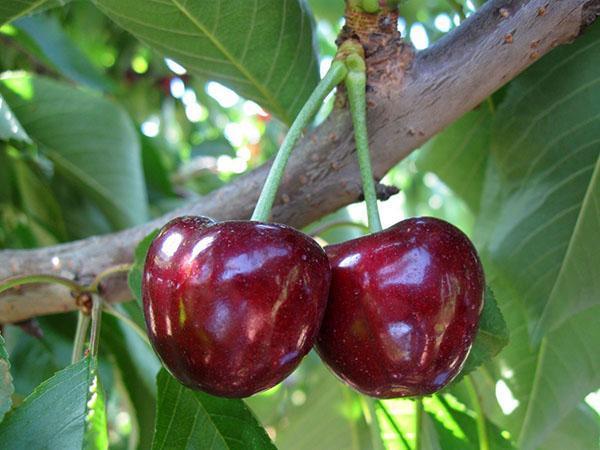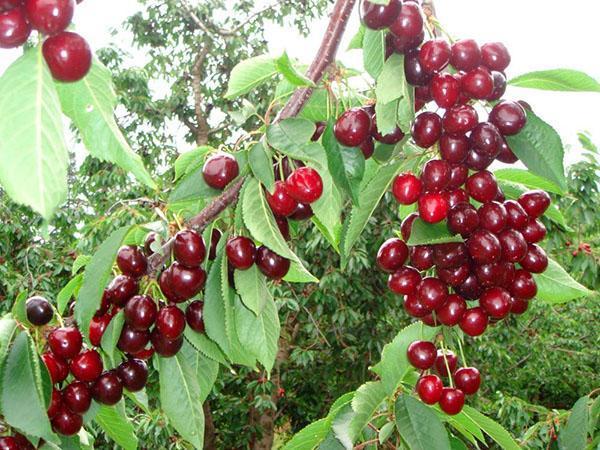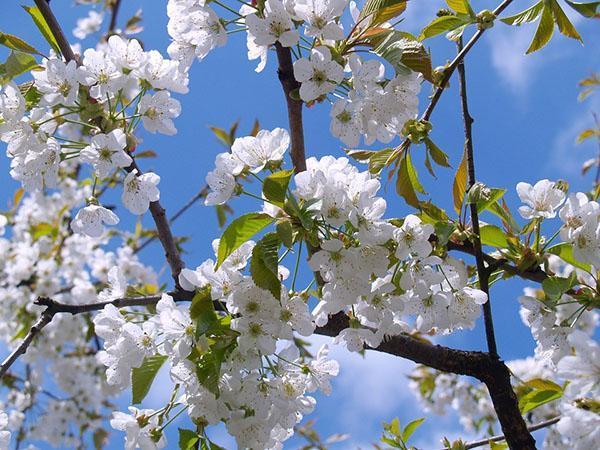Large-fruited sweet cherry variety Bull heart for summer residents of central Russia
 Every year, cherries have more and more fans among gardeners not only in the south, but in central Russia. Everyone wants to get sweet, full-bodied fruits, such as, for example, the Bull's Heart sweet cherry, which is considered the largest-fruited variety obtained by domestic breeders.
Every year, cherries have more and more fans among gardeners not only in the south, but in central Russia. Everyone wants to get sweet, full-bodied fruits, such as, for example, the Bull's Heart sweet cherry, which is considered the largest-fruited variety obtained by domestic breeders.
The culture received its name due to the rich dark red hue of the fruits and their external resemblance to the heart of a large powerful animal.
In Soviet times, this variety, also called the Wolf's Heart, was recommended for cultivation on the territory of Georgia, Azerbaijan and the south of the RSFSR, but today the boundaries of the comfort zone for the variety have somewhat expanded. There is a successful experience of obtaining stable yields in the farms of the Black Earth Region and even in the center of Russia.
However, success accompanies only those who patiently take care of planting, observe agricultural techniques and are well aware of the features, advantages and weaknesses listed in the description of the Bull Heart cherry variety.
Related article: the benefits of cherries for humans!
Characteristics of the sweet cherry variety Bull heart

Cherry Bull heart, as in the photo, has large leaves:
- rich green color;
- a wide lanceolate shape with a pointed tip and a rounded base that turns into a strong, short petiole;
- double-serrated edges of leaf plates.
The foliage on young shoots is usually larger than on perennial branches. The appearance of greenery practically coincides with the opening of the buds, which occurs in mid-May.
 Most of the flower buds are laid on short bouquet branches. The flowers are collected in 2–4 pieces, have a wide-open, saucer-like shape and a bright snow-white color.
Most of the flower buds are laid on short bouquet branches. The flowers are collected in 2–4 pieces, have a wide-open, saucer-like shape and a bright snow-white color.
Cherry Bull's heart is characterized not by mass, but by gradual ripening, the beginning of which in different regions can vary depending on the climate of the region and the weather in the spring-summer period. More often the first sweet cherry can be enjoyed in the second half of June or early July.
Fruiting and photo of cherries Bull heart
 Very large fruits weighing from 7 to 10 grams are the pride of this cherry variety. Very attractive in appearance, they stand out with a dark, sometimes almost black skin and red juicy pulp.
Very large fruits weighing from 7 to 10 grams are the pride of this cherry variety. Very attractive in appearance, they stand out with a dark, sometimes almost black skin and red juicy pulp.
Despite the sufficient density, the peel cannot protect ripe fruits from damage and crushing, therefore it is almost impossible to transport or store the sweet cherry crop.
The leveled fruits with melting flesh without coarse cartilage and medium-sized creamy pit are held on dense, short stalks. If not harvested immediately after ripening, they can remain on the branches for about a month. At the same time, the loss of quality is insignificant. When harvesting, the drupe easily, without damage, separates from the stalk.The stone leaves the pulp with little effort.
According to the description, sweet cherries of the Bull Heart variety deserve the highest rating on a five-point scale for their taste and can be used both fresh and as raw materials for conservation... The content of sugars and acids in the dense, pleasant-tasting pulp may vary. Their ratio and fruit taste depends on the weather and the care that the tree receives regularly.
Advantages and disadvantages of sweet cherries Bull heart
 Among the varieties of cherries grown in Russia, there are no completely self-fertile varieties. Without pollinators growing nearby, the bovine heart is far from bearing fruit at full strength, forming only 5-10% of the possible ovary.
Among the varieties of cherries grown in Russia, there are no completely self-fertile varieties. Without pollinators growing nearby, the bovine heart is far from bearing fruit at full strength, forming only 5-10% of the possible ovary.
Compared to the same large-fruited, but southern varieties, the Bull's Heart sweet cherry is quite well adapted to harsh winters. It enters the spring without serious damage after frosts of the order of -25 ° C. Perennial wood does not suffer, but flower buds may die. The same happens during spring frosts, but the next year the trees make up for the loss and are ready to show themselves in their best light.
To simplify the care of the Bull's heart cherry, a sunny place, closed from autumn and winter winds, is chosen for planting. In the neighborhood, pollinating varieties are necessarily planted, blooming at approximately the same time.
Large-fruited varieties are often prone to cracking. A bull heart is no exception. Usually, the skin does not stand up and bursts when the filling falls on a wet period. To prevent ripening fruits from being spoiled in favorable weather, it is worth limiting watering of trees.
 In most cases, planting successfully resists the defeat of harmful fungi, but prevention will not be superfluous. Spraying is carried out with an early vein before flowering and in autumn, when the near-stem circles are cleaned and sanitary pruning.
In most cases, planting successfully resists the defeat of harmful fungi, but prevention will not be superfluous. Spraying is carried out with an early vein before flowering and in autumn, when the near-stem circles are cleaned and sanitary pruning.